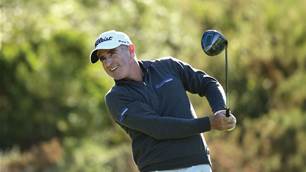There are few figures in the Australian sporting pantheon who require a shorter introduction than Mark Taylor.
 Photo courtesy of Channel 9
Photo courtesy of Channel 9There are few figures in the Australian sporting pantheon who require a shorter introduction than Mark Taylor. A technically gifted opening batsman who shaped his game around an unerring knowledge of where his off-stump stood; a tactically supreme captain who built the finest Test team this country has ever witnessed; a gifted commentator whose measured wisdom in the Channel Nine box has lifted him to the top tier of Australia’s sporting statesmen.
In short, a national treasure.
While Tubby’s cricketing legacy may be founded on his success against the West Indies, his legend was established during the 1989 Ashes Tour. Recall the scene: the Australians hadn’t won a series in England since 1975. Over its past 11 Tests, Allan Border’s team had recorded a bare two victories. The English press was branding the young squad the “worst ever” to
leave Australian shores. In the end, however, it was scarcely a contest. The Australians eviscerated the Poms in the first two Tests before marching to a 4-1 series victory. Amidst the carnage, none stood taller than Taylor. A century in the first Test and a sparkling 219 in the fifth paved the way for a series tally of 839 runs – the highest since Don Bradman’s 930 on the 1930 Ashes tour. With this month’s Ashes series in full flight, we collared the great man for a yarn.
What was the defining factor behind the Australian success on that 1989 Ashes tour?
I think it probably started back in the previous series. I’m not sure how good your memory is, but in the series before that Ashes, we’d played the West Indies in Australia and got belted by a very good side in the first three Tests. Now, I came in for the Sydney Test, which was the fourth match of the series. And we won, with Allan Border taking 11 wickets bowling his left-arm finger spin. After that match we went to Adelaide, where we had the better of that game as well. So I think we gained a lot of confidence from those two Tests. Even though we lost the series 3-1, we went to England confident. People had written us off, but we felt we were a much better side than people were giving us credit for. We went over there with a lot more confidence than people thought we deserved to have.
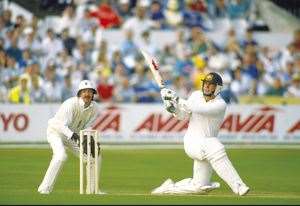 English ‘keeper Jack Russell cuts a helpless figure as Tubby marches to 219 at Trent Bridge in ‘89. Photo: Getty
English ‘keeper Jack Russell cuts a helpless figure as Tubby marches to 219 at Trent Bridge in ‘89. Photo: GettyDo you see a similar confidence in the current Australian team?
To be honest, no. It’s certainly not there at the moment. But, on a positive note, it can change pretty quickly. When I went over in ’89, I really didn’t know how I was going to go. I wasn’t sure I was good enough to be in the team. It wasn’t until that first Test at Headingley – where I made a hundred and Steve Waugh made his first Test hundred – that everything turned around. We suddenly realised we were Test cricketers – good Test cricketers. So confidence can change very quickly. That’s all a couple of members of the Australian top order need to turn things around for them.
You achieved incredible immediate success on that ‘89 series ... Well, I was over there the year before, playing in the Bolton league for a side called Greenmount. Although the pitches were very different to Test wickets, it meant I wasn’t totally surprised by the conditions I would get on that Ashes Tour. I’ve always found English pitches very good to bat on, full stop.
There’s a lot of talk about English conditions, and the capabilities of the Duke ball – is batting in England really so different?
I don’t believe so, no. I think there’s far too much talk about all that sort of stuff – more talk than actual reality. On that ’89 tour, it took me two or three weeks to get used to the pace of the pitches; I struggled early-doors to get runs in some of the county games. But when I did get used to the pace, I found it very even – probably more even and consistent than the pitches here in Australia. Sure, you’re going to get days over there that are overcast, when the ball’s going to do a bit more, but generally, once I got through that initial period, I always found England an excellent place to bat.
 Shane Watson: is this the technique that should secure a place at the top of the Australian order? Photo: Getty
Shane Watson: is this the technique that should secure a place at the top of the Australian order? Photo: GettyWhen you cast your technical eye over the batsmen in Australia’s squad, do you see irredeemable technical deficiencies?
Oh, I wouldn’t say that as a general comment ... Look at Shane Watson – technically he’s a very good-looking batsman. Same with Dave Warner.
I wouldn’t say the same for Cowan and Hughes; they’ve got their own techniques. But you don’t need to be a technical genius to be a great batsman. For me, looking at Australia’s top order, the main issue is that they’ve got four or five opening batsmen. The key’s going to be finding the right guys amongst those blokes. Look back to ’89, I broke up the Boon-Marsh opening partnership. Now, that was a bit of a gamble by the selectors. But } Swampy and I formed a good partnership at the top of the order and David Boon got very comfortable batting at three, so we stayed that way for a number of years. I think that’s what this Australian team needs to do – it needs to find a combination that works well. I tend to think that Watson’s got to be in that opening combination. He seems to play his best cricket when he’s opening the batting.
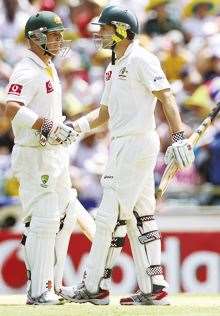 Can the Cowan-Warner partnership last? Photo: Getty
Can the Cowan-Warner partnership last? Photo: GettyI’m not sure. Is it Warner, Rogers or Cowan? They’re going to have to find someone who can open with Watson, giving them that left-right combination at the top. It might be that David Warner has to bat down the order, below Michael Clarke.
Have Australia’s selectors been blinded by youth over the past five or six years?
I don’t think so. You’ve got to keep looking to youth. Look at the guys who’ve played over the last few years but haven’t grabbed their opportunity. Look at Usman Khawaja – he’s a good-looking player. Technically he should make it. He just hasn’t been able to nail down that spot as yet. What’s the other option? Keep picking the old blokes all the time? Eventually you run into the situation where they all leave together and you’ve got no young players to come through. I think it’s harsh criticism to say the selectors have been blinded by youth.
Is there a culture problem in the Australian team right now?
[Pauses] There’s certainly a different culture. And it’s a culture that needs to improve – I’d say that much. Look, I don’t know everything that’s going on in the team, but it’s certainly true that little issues keep poking up. This suggests to me that things aren’t right.
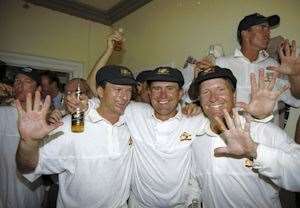 “That core of senior players ... ” Steve Waugh, Taylor and Ian Healy celebrate a fifth-straight Ashes series victory in ‘97. Photo: Getty
“That core of senior players ... ” Steve Waugh, Taylor and Ian Healy celebrate a fifth-straight Ashes series victory in ‘97. Photo: GettyThere’s no doubt – with the amount of T20 cricket being played these days – that there’s a completely different culture to when I played. Back then, you played for the Test matches. In that ’89 Ashes series, we went away for six months and we forged a culture. These days, blokes tend to fly in for a few games and fly off. So they don’t forge that team bond. Somehow they’ve got to try and find that – and it’s not going to be easy. They’ve got to find that core of senior players that sticks together and says, “The culture is this.” At the moment, I don’t know who those senior players are, but Australian cricket desperately needs them.
Who should they be?
Well, it should be Clarke, Watson, Haddin, Warner and Siddle. There’s your five blokes. But in the lead up to this Ashes series, we had Michael Clarke injured, so he hasn’t been around the team. We had Siddle and Haddin playing for Australia A, so they weren’t with the Champions Trophy group. And we had David Warner finding himself in trouble. So I don’t sense the core values of the side are being set by the senior players.
 “When AB returns with the the urn, the urn ...” Tough decisions led to glittering success for Border in ‘89. Photo: Getty
“When AB returns with the the urn, the urn ...” Tough decisions led to glittering success for Border in ‘89. Photo: GettyAllan Border was renowned for being a tough captain. With Mickey Arthur gone, does Clarke need to be a harsher captain?
No, I don’t think you necessarily have to be harsh. But I think you need to set standards that have to be met by the team. And that’s not the case at the moment. Back in ’89, I distinctly remember Allan Border saying that in ’81 and ’85, the team started splitting up halfway through the campaign.
He found that when wives and partners came over to England, the team tended to break up, go its own way. Of course, Australia lost both those series after making good starts. So in 1989, AB said, “Righto, we’re staying together, team only, until we win the Ashes. If you want to bring your wife or your girlfriend, they’re not to join the team. They’re separate.” It was a harsh call; a big call. But, rightly or wrongly, that team stuck together and formed the basis for a side that only improved from then on. So I think some tough decisions need to be made to set the right example for this team.
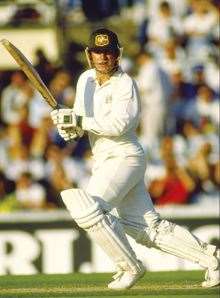 Tubby and his trusty Symonds, circa ‘89. Photo: Getty
Tubby and his trusty Symonds, circa ‘89. Photo: GettyFielding has always been something Australian teams have prided themselves on, but of late we seem to be regularly out-fielded in all forms of the game. Is this a sign of a commitment problem?
I think it’s more an emphasis problem. In recent times, particularly with the birth of T20 cricket, there’s been far more emphasis placed on fitness, strength and ground fielding. Yes, these days blokes throw themselves around in the field, but I don’t think there’s been enough emphasis placed on catching – particularly catching in the ring. These are the catches that win Test matches. So I think our top-order batsmen have to do what I did – if you’re not going to bowl, you have to be a good catcher. When David Boon started, he wasn’t a great catcher at all, but he tuned himself into a good bat-padder through hard work. This is what blokes like Cowan and Hughes have to do.
It’s 18 months since the Argus Report was released. Now you’re back on the Cricket Australia board, are you satisfied the recommendations of that report are being put in place?
Oh gee, that’s a very tough question! There were 50-odd recommendations in that report and probably 13 of them were major recommendations. Look, I think it’s a work in progress. A lot of recommendations made in that report need to be constantly adhered to. So it’s an ongoing work. Is it close to being complete? No way. We’ve got a lot of work to do.
– Aaron Scott

